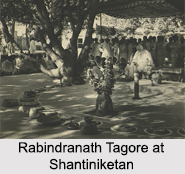 Shantiniketan is a small town which is known for its unsurpassed natural, intellectual and cultural heritage. It has become a tourist spot because of its association with Rabindranath Tagore. It is located near Bolpur in the Birbhum district of West Bengal which embodies Rabindranath Tagore"s dream of a place of learning. It is approximately 180 kilometres north of Kolkata.
Shantiniketan is a small town which is known for its unsurpassed natural, intellectual and cultural heritage. It has become a tourist spot because of its association with Rabindranath Tagore. It is located near Bolpur in the Birbhum district of West Bengal which embodies Rabindranath Tagore"s dream of a place of learning. It is approximately 180 kilometres north of Kolkata.
History of Shantiniketan
Shantiniketan was established by Maharshi Devendranath Tagore and later expanded by his son Rabindranath Tagore. It was earlier called "Bhubandanga" and was owned by the Zamindar Sinha family. In 1862, Maharshi Debendranath Tagore showed interest in land near Birbhum. There was only one building there namely `Shantiniketan`. Maharshi liked the place and registered it in the name of Maharshi Devendranath against Rupee One as a token value. He called his home Shantiniketan (after the name of the house). He founded an ashram here in 1863 and became the initiator of the Brahmo Samaj.
Rabindranath Tagore started "Patha Bhavana" whose central ground was that learning in a natural environment. After he received the Nobel Prize in 1913, the school was expanded into a university in 1921. In the year 1924 with the purpose of educating and training the people belonging to disadvantaged part of the society he founded "Siksha-Satra" with only 7 students. The journey initiated by Rabindranath. It was recognised in the year 1951 by central government. Shantiniketan grew into the Visva Bharati University in 1921 attracting some of the most creative minds in the country. Rabindranath wanted his students to feel free despite being in the formal learning environment of a school.
 Climate of Shantiniketan
Climate of Shantiniketan
Shantiniketan is at 23.68 degree North, 87.68 degree East. It has an average elevation of 56 metres (187 feet). The climate of Shantiniketan is somewhat humid. July and August witness heavy rainfall.
Attractions of Shantiniketan
The various buildings of different themes are designed by Rabindranath Tagore himself and inside the Visva-Bharati campus; these buildings are the main attractions of Shantiniketan. The houses are named as "Dehali", "China Bhavana", "Black House", "Shantiniketan Griha", "Kala Bhavan", "Uttarayan Complex", "Bichitra", "Sangeet Bhavan" and "Chhatimtala". Rabindranath started a rural reconstruction centre at Shriniketan in the year 1922, which is 3 kilometres from Shantiniketan. This is the centre for traditional handicrafts like batik, pottery, weaving, Kantha embroidery and Dokra tribal handicrafts.
The whole place of Shantiniketan is reminiscent of the great poet Rabindranath Tagore and his vision of International University. Shantiniketan is famous for its various festivals also like "Poush Mela", "Maghotsab", "Basanta Utsab" etc. The "Dol Jatra" of Shantiniketan is very impressive where the entire campus is decorated with "alpana" and people sing Holi songs based on Rabindrasangeet.
There are other tourist attractions in Shantiniketan like "Kankalitala", which is one of the sacred Shakti Peethas, located on the bank of the Kopai River. Others are "Fullora", "Nalhati", "Bakreshwar", "Massanjore", "Kendubilwa", "Nanoor", "Tarapith". "Tagore`s Ashram" is one of the must visit places in Shantiniketan which was founded in 1863 by his father, Maharishi Devendranath Tagore. "Amar Kutir" showcases a number of locally made handicrafts, including leather printed bags, printed cloth etc. Rabindra Bhaban Museum is the most enjoyable place for historical inquisitiveness which includes the Nobel Prize Medallion received by Tagore.
"Upasna Ghar" is one of the most stunning buildings in all of Shantiniketan which is made from Belgian Glass. It is also called "Kanch Mandir", which derives its name from the glass laden walls. Deer Park is about 3 kilometres from the main campus that is the "Ballavpur forest". The forest shelters a naturally bred large family of deer. It is now known as the deer park. `Sonajhuri` is a tourist place, which is 3.1 kilometres from Shantiniketan which is largely celebrated for `Shonibarer Haat` (Saturday`s market).
Visiting Information of Shantiniketan
Trains direct run to Bolpur from Howrah and Sealdah station on daily basis. Bus from Durgapur City Centre Bus Stop and Dharmatala Bus Stop in Kolkata is also available for Shantiniketan.



















